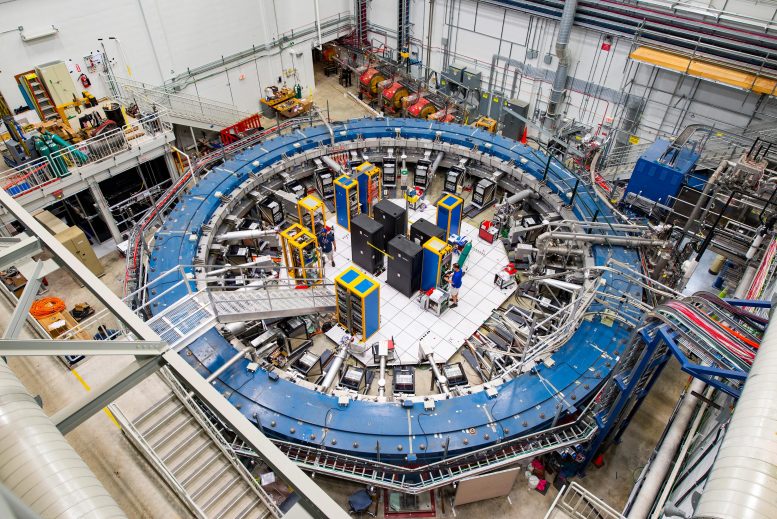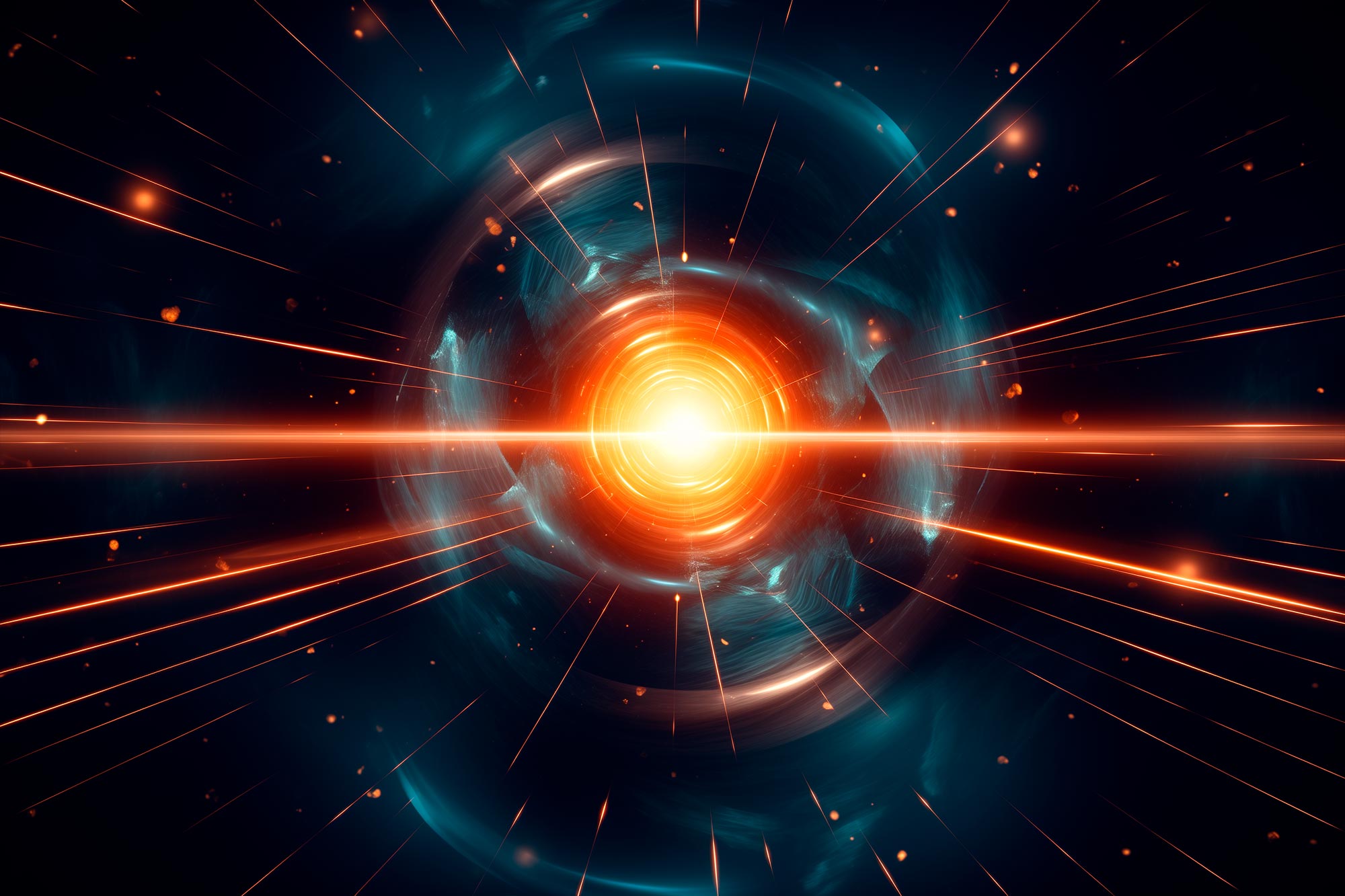The magnetic moment of the muon has posed a scientific puzzle due to the slight difference between its theoretical and experimental values, suggesting interactions with unknown particles or forces. Research involving advanced quantum simulations has started to unravel these discrepancies, offering insights into the fundamental properties of muons and their interactions in particle physics. Credit: SciTechDaily.com
The researchers identified the origin of discrepancies in recent predictions of the muon’s magnetic moment. Their findings could contribute to the investigation of dark matter and other aspects of the new physics.
Magnetic moment is an intrinsic property of a particle with spin, arising from interaction between the particle and a magnet or other object with a magnetic field. Like mass and electric charge, magnetic moment is one of the fundamental magnitudes of physics. There is a difference between the theoretical value of the magnetic moment of a muon, a particle that belongs to the same class as the electron, and the values obtained in high-energy experiments conducted in particle accelerators.
The difference only appears at the eighth decimal place, but scientists have been intrigued by it since it was discovered in 1948. It is not a detail: it can indicate whether the muon interacts with dark matter particles or other Higgs bosons, or even whether unknown forces are involved in the process.
Discrepancies in Muon’s Magnetic Moment
The theoretical value of the muon’s magnetic moment, represented by the letter g, is given by the Dirac equation – formulated by English physicist and 1933 Nobel Prize winner Paulo Dirac (1902-1984), one of the founders of quantum mechanics and quantum electrodynamics – as 2. However, experiments have shown that g is not exactly 2 and there is a great deal of interest in understanding “g-2”, i.e. the difference between the experimental value and the value predicted by the Dirac equation. The best experimental value currently available, obtained to an impressive degree of precision at the Fermi National Accelerator Laboratory (Fermilab) in the United States and announced in August 2023, is 2.00116592059, with an uncertainty range of plus or minus 0.00000000022.
“Precise determination of the muon’s magnetic moment has become a key issue in particle physics because investigation of this gap between the experimental data and the theoretical prediction can provide information that could lead to the discovery of some spectacular new effect,” physicist Diogo Boito, a professor at the University of São Paulo’s São Carlos Institute of Physics (IFSC-USP), told Agência FAPESP.
An article on the subject by Boito and collaborators is published in the journal Physical Review Letters.
New Insights From Research
“Our results were presented at two important international events. First by me during a workshop in Madrid, Spain, and later by my colleague Maarten Golterman of San Francisco State University at a meeting in Bern, Switzerland,” Boito said.
These results quantify and point to the origin of a discrepancy between the two methods used to make current predictions of muon g-2. “There are currently two methods for determining a fundamental component of g-2. The first is based on experimental data, and the second on computer simulations of quantum chromodynamics, or QCD, the theory that studies strong interactions between quarks. These two methods produce quite different results, which is a major problem. Until it’s solved, we can’t investigate the contributions of possible exotic particles such as new Higgs bosons or dark matter, for example, to g-2,” he explained.
The study succeeded in explaining the discrepancy, but to understand it we need to take a few steps back and start again with a somewhat more detailed description of the muon.

The muon storage ring at Fermilab. Credit: Reidar Hahn, Fermilab
The muon is a particle that belongs to the class of leptons, as does the electron, but has a much larger mass. For this reason, it is unstable and survives only for a very short time in a high-energy context. When muons interact with each other in the presence of a magnetic field, they decay and regroup as a cloud of other particles, such as electrons, positrons, W and Z bosons, Higgs bosons, and photons. In experiments, muons are, therefore, always accompanied by many other virtual particles. Their contributions make the actual magnetic moment measured in experiments greater than the theoretical magnetic moment calculated by the Dirac equation, which is equal to 2.
“To obtain the difference [g-2], it’s necessary to consider all these contributions – both those predicted by QCD [in the Standard Model of particle physics] and others that are smaller but appear in high-precision experimental measurements. We know several of these contributions very well – but not all of them,” Boito said.
The effects of QCD strong interaction cannot be calculated theoretically alone, as in some energy regimes they are impracticable, so there are two possibilities. One has been used for some time and entails resorting to the experimental data obtained from electron-positron collisions, which create other particles made up of quarks. The other is lattice QCD, which became competitive only in the current decade and entails simulating the theoretical process in a supercomputer.
“The main problem with predicting muon g-2 right now is that the result obtained using data from electron-positron collisions doesn’t agree with the total experimental result, while the results based on lattice QCD do. No one was sure why, and our study clarifies part of this puzzle,” Boito said.
He and his colleagues conducted their research exactly to solve this problem. “The article reports the findings of a number of studies in which we developed a novel method to compare the results of lattice QCD simulations with the results based on experimental data. We show that it’s possible to extract from the data contributions that are calculated in the lattice with great precision – the contributions of so-called connected Feynman diagrams,” he said.
American theoretical physicist Richard Feynman (1918-1988) won the 1965 Nobel Prize in Physics (with Julian Schwinger and Shin’ichiro Tomonaga) for fundamental work in quantum electrodynamics and the physics of elementary particles. Feynman diagrams, created in 1948, are graphical representations of the mathematical expressions that describe the interaction of such particles and are used to simplify the respective calculations.
“In the study, we obtained the contributions of connected Feynman diagrams in the so-called ‘intermediate energy window’ with great precision for the first time. Today we have eight results for these contributions, obtained by means of lattice QCD simulations, and all of them agree to a significant extent. Moreover, we show that the results based on electron-positron interaction data don’t agree with these eight results from simulations,” Boito said.
This enabled the researchers to locate the source of the problem and think about possible solutions. “It became clear that if the experimental data for the two-pion channel are underestimated for some reason, this could be the cause of the discrepancy,” he said. Pions are mesons – particles made up of a quark and an antiquark produced in high-energy collisions.
In fact, new data (still being peer-reviewed) from the CMD-3 Experiment conducted at Novosibirsk State University in Russia appears to show that the oldest two-pion channel data may have been underestimated for some reason.
Reference: “Data-Driven Determination of the Light-Quark Connected Component of the Intermediate-Window Contribution to the Muon g−2” by Genessa Benton, Diogo Boito, Maarten Golterman, Alexander Keshavarzi, Kim Maltman and Santiago Peris, 21 December 2023, Physical Review Letters.
DOI: 10.1103/PhysRevLett.131.251803
Boito’s participation in the study was part of his project “Testing the standard model: precision QCD and muon g-2,” for which FAPESP awarded him a Phase 2 Young Investigator Grant.

Dr. Thomas Hughes is a UK-based scientist and science communicator who makes complex topics accessible to readers. His articles explore breakthroughs in various scientific disciplines, from space exploration to cutting-edge research.








